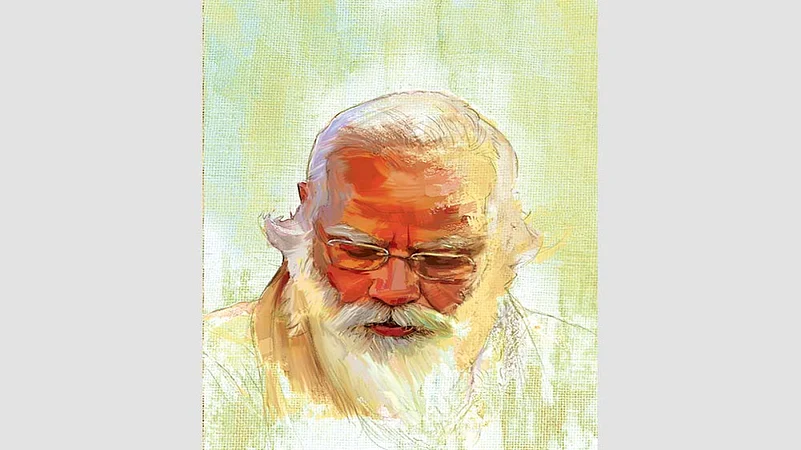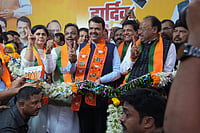As I write these words from my Covid sickbed—despite being vaccinated, I have been hit hard, with a diagnosis of Covid-induced viral myocarditis and intense fatigue—I am acutely conscious of our nation’s trauma in the face of the pandemic.
As the cumulative number of infections crosses 2 crore by the first half of May and the cumulative death toll passes 3 lakh (though experts estimate the real toll to be eight times as much), as hospital beds began to overflow, oxygen supplies dwindled, vaccination centres ran out of vaccines and pharmacies were unable to meet the overwhelming demand for anti-virals, India is reeling from its failure to cope with Covid. The Congress denounced the government for presiding over “a saga of tragedy, incompetence and colossal mismanagement”. But this is not an Opposition view, it is that of the common citizen of India.
ALSO READ: Twice Orphaned
How did everything go so wrong so soon after India was being described around the world as a success story, having recovered from the “first wave” last year, resumed normal life and economic activity, and started exporting vaccines?
The list of errors is indeed long.
Symbolism over substance: Prime Minister Modi’s penchant for drama and theatre was on full display, trying to make Covid into an issue to rally the people behind him by such expedients as demanding on national television that people bang plates together at an auspicious hour, and two weeks later urging them to light lamps at a specific moment. Superstitious displays like this were a substitute for serious scientific thinking at policy levels about measures to confront the pandemic. The prime minister’s Hindu nationalism was on full display as he claimed that, just as the epic Mahabharata war was won in 18 days, India would win the war against Covid in 21 days. At no stage was it suggested that this was based on anything more than wishful thinking.
ALSO READ: The Empire Of Cruelty
WHO mantra unheeded: From the start of the crisis, WHO recommended a containment strategy that required testing, tracing of contacts, isolation and treatment. While a handful of states—like Kerala, which recorded India’s first Covid case on January 30, 2020—initially implemented this mantra successfully, the central government’s ham-handed response resulted in uneven application of such measures in several states.
ALSO READ: The Seventh Seal
Centralisation: From the first nationwide lockdown, announced by Prime Minister Modi himself in March 2020 with less than four hours’ notice, the Covid crisis was handled top-down by the central government under obscure provisions of the Epidemic Act and the Disaster Management Act, which allowed it to ride roughshod over the federal structure. Instead of allowing India’s 30 state governments the authority to design locally relevant strategies and administrative measures, the central government tried to manage Covid by decree from Delhi, with calamitous consequences. (A year later came proof that the government’s interpretation of federalism involved power without responsibility: last week, the Delhi government had to get an order from the Supreme Court to direct the central government to supply oxygen to save the lives of hundreds of patients.)
ALSO READ: Jantar Mantar Is Just A Sundial. Period
Mismanaged lockdown: Modi announced a sudden lockdown in March 2020 without any notice to state governments, the public or even to officials of the central government itself, who were caught unprepared. The result was chaos, including the mass movement home of some 30 million migrant workers for whom no provisions had been made, and a shutdown of all economic activity. It is estimated that 198 people died on the long trudge home. Some 5 million micro and small enterprises closed, unable to recover from the shutdown. India’s unemployment reached the highest levels ever recorded.
ALSO READ: Union Of Federal Uncooperative
Insufficient funding: As the crisis began to slip out of control, the central government passed more responsibility onto state governments, without adequate funding. The state governments struggled to mobilise doctors, nurses, health workers, testing kits, personal protective equipment, hospital beds, ventilators, oxygen cylinders and medicines to fight the pandemic. The government mobilised a huge amount of funds for a new relief entity called ‘PM-Cares’, but to this day there is no public accounting of how much money is in the opaque PM-Cares Fund and where its resources have been allocated.
ALSO READ: ‘Modi Brought India To Its Knees’
Complacency: When the pandemic seemed to have waned, the authorities settled into complacency, taking no precautions or preventive measures against a possible second wave that many warned could be more devastating than the first. The practice of testing, tracking, isolating and tracing of infected persons and their contacts fell rapidly into disuse by the end of 2020. It was just when people stopped following Covid-appropriate behaviour that the virus also mutated, evolved an extremely infectious variant, and spread more rapidly. Super-spreader events proliferated: crowded election campaigns, mass rallies and jampacked religious festivals were conducted with huge unmasked throngs in close proximity to each other. The contagion raged like wildfire.
ALSO READ: The People’s Prime Minister
Lack of planning: Between the two waves of Covid, the government had time to prepare—to build our medical infrastructure, to augment the number of beds and to both enhance and streamline the supply of critical resources like oxygen, ventilators and drugs used for Covid treatment. It also had the time to focus on expanding the procurement and distribution of vaccines across the country, so as to ensure a greater number of our citizens were kept safe from the virus. This opportunity, and the time available, were simply wasted. On all fronts, there has been a colossal failure on the part of the government. Just last week, the Supreme Court was forced to constitute a 12-member National Task Force to streamline and ensure the “effective and transparent” allocation of liquid medical oxygen on a “scientific, rational and equitable basis” to states and Union territories fighting COVID-19.
ALSO READ: The Illusion Of Eternity
Vaccination delays: The government, proud of India being the producer of 60 per cent of the world’s vaccines, took no steps to scale up the production and supply of the two Covid vaccines cleared for manufacture in the country. Nor did it permit the import of foreign vaccines, help expand available manufacturing facilities or extend them under licence to other Indian firms. India began vaccination nearly two months after Britain, and even then, only of health workers and “frontline” workers, including police and security personnel. By April, only 37 per cent of healthcare workers, and barely 1.3 per cent of India’s 1.34 billion population, had been fully vaccinated. Only 8 per cent had one vaccine shot.
ALSO READ: At Least The Black Market Is Working!
Vaccination mismanagement: The government failed to place orders to manufacture vaccines in time to prepare the vulnerable for the anticipated second wave. It was only in the third week of April that the government delegated the vaccine rollout to state governments and public and private hospitals. Out of misplaced “vaccine nationalism”, it also refused to grant emergency-use approval to vaccines from abroad, leading to a nationwide shortage of vaccines in India by mid-April (at which point it had to approve the import of vaccines already approved by the US, the UK, European Union, Russia and Japan). On top of this man-made shortage, the central government failed in its responsibility to distribute vaccines fairly and equitably to the various states, resulting in some of the worst-affected (like Opposition-ruled Maharashtra and Kerala) running short of vaccines while cases were peaking.
Misplaced priorities: The government went forward with the construction of the extravagant and arguably unnecessary Rs 20,000 crore Central Vista project, including a grandiose new residence for the PM, amid the lockdown in the nation’s capital, declaring the construction work an “essential service”—even while genuinely essential services like oxygen supplies were unavailable. Meanwhile, it passed on the financial burden of vaccinating a majority of India’s citizens to the states, while announcing a policy that meant states would have to pay a higher procurement price than the central government. It did not provide a comprehensive fiscal stimulus to our ailing economy or direct cash transfers to support the economically vulnerable segments of our society. The government has largely left citizens to fend for themselves. The sheer heartlessness and lack of empathy on display would have been unimaginable in any other democracy. The government’s inefficiency and inattention came in for justified and widespread condemnation.
Authoritarianism and bigotry: As public anger mounted against the government, the ruling party and BJP governments in several states took increasingly undemocratic measures to suppress or divert it, from the diktats of UP CM Yogi Adityanath to book those complaining of oxygen shortages under sedition charges, to the foreign ministry instructing its diplomats to defend the indefensible by challenging the critics of the government’s failures, and from pressing social media sites Facebook and Twitter to delete posts critical of the government’s performance, to the communal bigotry paraded by a trio of Karnataka BJP MLAs and Bangalore South MP Tejasvi Surya calling out the names of Covid “war-room” staff from the Muslim community to cover up the failures of the Municipal Corporation run by their own party. This crisis has shown our authorities’ ugliest faces at their least sympathetic.
ALSO READ: The Go-Getter, Downsized
This is why it is time for us to admit the government was prematurely self-congratulatory. India’s ‘vaccine maitri’ programme of exports was hubristic when Indians were unable to access the vaccines that might have protected them. The PM’s January proclamation at Davos of victory over Covid, when he had done nothing to build up stocks of oxygen, vaccines, medical personnel or other necessary resources for the impending second wave, will long haunt India’s reputation globally. Today mortuaries, graveyards and crematoria are running out of space, wood and processing capacity, and the “peak” shows no signs of having been reached. Those ministers who proclaimed that the “whole world has praised the manner in which the prime minister has tackled the pandemic” must apologise to the nation for having let the Indian people down.
(The author is a congress MP and author. Views are personal)
















